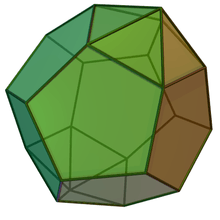Parabiaugmented dodecahedron
| Parabiaugmented dodecahedron | |
|---|---|
 | |
| Type |
Johnson J58 - J59 - J60 |
| Faces |
10 triangles 10 pentagons |
| Edges | 40 |
| Vertices | 22 |
| Vertex configuration |
10(53) 10(32.52) 2(35) |
| Symmetry group | D5d |
| Dual polyhedron | - |
| Properties | convex |
| Net | |
 | |
In geometry, the parabiaugmented dodecahedron is one of the Johnson solids (J59).
A Johnson solid is one of 92 strictly convex polyhedra that have regular faces but are not uniform (that is, they are not Platonic solids, Archimedean solids, prisms or antiprisms). They were named by Norman Johnson, who first listed these polyhedra in 1966.[1]
It can be seen as a dodecahedron with two pentagonal pyramids attached to opposite faces. When pyramids are attached to a dodecahedron in other ways, they may result in an augmented dodecahedron, a metabiaugmented dodecahedron, a triaugmented dodecahedron, or a small stellated dodecahedron.
External links
- ↑ Johnson, Norman W. (1966), "Convex polyhedra with regular faces", Canadian Journal of Mathematics 18: 169–200, doi:10.4153/cjm-1966-021-8, MR 0185507, Zbl 0132.14603.
This article is issued from Wikipedia - version of the Wednesday, November 04, 2015. The text is available under the Creative Commons Attribution/Share Alike but additional terms may apply for the media files.